
The photo shows tracks of some of the most common chicken predators, but this post also covers scat, feeding sign, and behavior.
This is a fairly thorough guide to common poultry predators of the US, with emphasis on tracks, scat, and behavior. Instead of simplified drawings, I use photos of a actual tracks I have found, to give a better sense of what they really look like. This is more detailed than many other guides for poultry farmers, because reliance on overly simplistic information leads to misdiagnosis, misunderstanding, frustration, and higher impact intervention (shooting, trapping, and poisoning). My intention is to educate and inspire a respect for wildlife. Hopefully, this will encourage responsible livestock protection, which allow you to coexist with predators. And if you’re interested in wildlife, check out my blog dedicated to tracking and photographing wildlife with motion sensitive cameras, at Winterberry Wildlife.
Things to keep in mind when determining which predator:
- Animals are not machines, so don’t expect them to always leave the “classic” sign. Behavior is influenced by many factors. A hungry animal will eat more than a not so hungry animal. An animal weakened by exhaustion, starvation, or illness will be less able to carry prey away. A migrating individual will not be familiar with your habits, and might take risks that resident animals would not. A predator startled during an attack might flee before leaving classic sign.
- Track appearance varies enormously depending on substrate, weather, and time elapsed since the track was left. Perfect, textbook tracks are rarely seen. The examples in my photos are among the clearest and best I’ve found in 10 years of photographing tracks. Tracks you find near your coop may be far less distinct.
- There is much more to tracking than what I’ve presented here. For example, knowledge of trail patterns is often necessary, but that is beyond the scope of this. I encourage you to read more about tracking.
This post contains links to online shopping, which is a way for you to support One Acre Farm at no additional cost to you. Click here for my full affiliate disclosure. Thanks for your support!
Poultry Predator Identification
Humans
Suspect this clever predator when birds disappear from a secure area, leaving no trace. These are sneaky beasts with dextrous front paws and large brains, capable of tremendous damage despite fencing, gates, locks, and guardian animals. Seriously, I include ourselves here to drive home the point that predators are not the bad guys and we the good. We, too, are predators. We have much more in common with wild animals than we care to admit.
Dog Family
This includes dogs and wild canids, such as wolves, coyotes, and foxes. Tracks show 4 toes, usually with claw marks. Scats vary, depending on the animal’s diet.
Dog
Domestic dogs are usually well fed and don’t eat their prey. Tracks of all members of the dog family are similar, but those of dogs vary more than those of wild species, because there are so many different breeds.
-
Tracks usually show a very prominent triangular heel pad and prominent claw marks. Outer toes might stick out to the side somewhat.
- Scat bears the sign of a diet high in grains: smooth and grainy, without any twist.
- Suspect them when many birds have been killed but none eaten, and they don’t bear the typical signs of other wild predators.
Coyote
Eastern and western coyotes are considered the same species, but there are important differences. Western coyotes are much smaller (and therefore tracks and scats are smaller), more solitary, and focus on smaller prey, such as rodents and rabbits. Eastern coyotes are intermediate between western coyotes and wolves, and in fact carry a small percentage of wolf DNA. They are more social than western coyotes, may hunt in small packs, occasionally take larger prey, and may go after livestock much larger than chickens. Read more about eastern coyotes here.
- Tracks are very streamlined, with all 4 toes pointing forward, the 2 leading toes close together, pinpoint claw marks, and heel pad impression fainter than toe pad impressions.
- Scat depends on the diet of this omnivore. It may contain fruit or berries, or fur or bone fragments. If it contains fur, it appears twisted. Scats tend to measure 1/2 inch to 1 and 1/4 inches in diameter. Larger bone fragments in scat help distinguish coyote from foxes, which are much smaller and cannot crunch larger bones in their jaws.
- Scat is often left at prominent locations, and sometimes on elevated surfaces (stone or log).
- One or many birds may be killed, all might be carried away. Piles of feathers and even some dead birds might be left behind. You might notice evidence of biting on the back of the neck (broken neck, neck feathers missing).
- Usually active at dawn, dusk, and during the night, around human habitations, but bold enough to venture out in broad daylight when hunger calls and livestock appear easy to take.
- Will dig under fences and chew through chicken wire.

Coyote tracks are streamlined, and scat may show bone fragments that are somewhat large, as seen here.
Fox
There are several species of fox in North America. Two common, wide ranging species are the red fox and the gray fox. Both hunt singly (except when teaching young) and focus on small prey. The largest individuals weigh only about 12-15 lbs, and many are half that weight. Carrying an adult standard sized chicken is a challenge for this small predator, which may drop its prey to make a quick escape when frightened.
- Tracks tend to be streamlined, but smaller than those of coyote. Heel pads appear much smaller than those of coyote tracks, due to an abundance of fur on the bottom of the foot, which obscures the heel pad print. Here’s a post on tracking red fox and distinguishing their tracks from those of coyote and dog.
- Scats vary by diet, and look like coyote scats but smaller – no more than 3/4 inch in diameter. It appears twisted when it contains fur.
- Foxes are notorious for leaving scat where it’s very noticeable, especially on elevated surfaces (on a stone or log, for example).
- Red fox urine smells like skunk spray, but much fainter. You can get a whiff of it in the air, but it doesn’t knock you over. Gray fox urine smells similar, but even fainter. You can’t smell it unless you put your nose close to it.
- Usually active at dawn, dusk, and during darkness where human activity is high, but will hunt during daylight if prey appears easy to get.
- Will dig under fencing and chew through chicken wire.

Left column: red fox and its tracks and scat. Note that scat is prominently located on a piece of trash. Right column: gray fox and its tracks and scat. Note that both species have small heel pads, and that of red fox is often nothing more than a bar. The red fox is bolder around people, and is the more common chicken predator.
Cat family
This includes domestic cats and wild felines, such as bobcats and cougars (also called puma, panther, and mountain lion). The lynx, a large footed, northern relative of the bobcat, will probably also take small livestock when easily available, but they don’t live in the suburbs like bobcats. Feline tracks show 4 toes, usually without claw marks, and a large heel pad shaped somewhat like a trapezoid.
House cat
Many house cats will kill young chicks, given the opportunity. Hatchlings may be entirely consumed. Wings, feathers, head, and/or feet of growing birds may be left behind. The largest, boldest or hungriest will attempt to kill adult, standard sized chickens. Growing birds are in a gray area. My cats generally ignore pullets over about 6 weeks of age. All of my cats, however, study baby chicks with great interest, so I keep the chicks inaccessible.
- Tracks are small and round, measuring about 1 to 1.5 inches in diameter.
- House cats usually cover their scat. When you see one, it usually appears segmented but not twisted. It may contain fur, if the cat has been feeding on small mammals. It might contain a small amount of grass, but will never contain a lot plant matter. It will not contain large bone fragments, because domestic cats cannot crush large bones.
Bobcat
This wild feline is about twice the size of a house cat, and frequents rural, suburban, and occasionally urban areas. In some parts of the US, bobcats have become bold around humans, and might pose a significant threat to small livestock at any hour. Bobcats are common here in Massachusetts, but are typically reclusive. That may change as they adapt to the suburbs.
- Tracks are virtually identical to house cat track, though larger, measuring about 1.5 to 2.5 inches in diameter. More details about tracking bobcats here.
- Bobcats usually do not cover their scat, and frequently place them in obvious locations. Like house cat scat, bobcat scat usually appears segmented but not twisted, and never contains a lot of vegetation, nor large bone fragments.
- Bobcats frequently spray urine onto vertical surfaces, much like intact house cats. It smells just like house cat urine.
- Bobcats tend to bite the back of the neck and shoulders of adult chickens.
Cougar
These large cats are not common chicken predators because they prefer much larger prey. However, any poorly protected livestock, including chickens, can appear on the cougar’s menu.
- Track measures 2 and 3/4 to 4 and 3/4 inches in width, and has the same general appearance as tracks of the smaller cats.
- Scats are about 3/4 to 1.5 inches in diameter, placed in the open, in a scrape (cat scrapes ground with front paws), or covered.
- Large animals are killed by a bite to the back of the neck.
Weasel family
This group of capable hunters includes, in North America, fisher, marten, mink, river otter, badger, wolverine, and 3 species of small weasel. Otters eat mostly fish and crayfish and are not likely to take chickens. We don’t have marten, badger or wolverine in Massachusetts, so I have not included them.
Fisher
Often called a “fisher cat”, this member of the weasel family is not a cat at all. It usually weighs 5-15 lbs, but the long tail and rich pelt make it look larger. Fishers eat mostly small rodents, rabbits, and carrion, and will take small livestock if the opportunity arises.
- Tracks show 4 or 5 toes (the smallest one does not always register), and a C-shaped metacarpal pad. There is also a heel pad which may or may not show in the track.
- Scats look a lot like fox scats, and like the fox, the fisher often places scat on elevated surfaces.
- Fishers are excellent climbers and diggers.
- More active at night, when living close to humans, but occasionally seen during daylight, especially in the northeast, where they’re adapting well to suburbs.
- May kill many chickens in one visit, in effort to cache for future consumption.
Mink and smaller weasels
Mink are semi-aquatic, and hunt both on land and in water, and will take chickens when available. They weigh only 2-4 lbs, and their long skinny bodies can fit through small openings. Weasels are even smaller, and the smallest ones can slip through a 1 inch diameter hole. Weasels are probably more interested in rodents dwelling in livestock housing, but will kill chickens as well.
-
Tracks and trails look like miniature versions of fisher tracks and trails. The track width is usually about 1 to 1.5 inches for mink. The smallest weasels may have tracks no wider than 1/2 inch.
- Scat reflects the diet. For the mink, scat can be up to 7/16 inches in diameter. For weasels, scat may be up to 3/8 inch in diameter. If it contains fur, it may appear twisted.
- These small predators may need to bite full sized chickens repeatedly on the head and neck to kill them. Sometimes they eat only the heads, and often they kill multiple birds. This surplus killing is probably done with the intention of returning to dine later, when hungry. Because humans also store great quantities of food for future meals, it is ironic that they often condemn the weasel’s behavior as “senseless killing”.
- Mink and weasels climb well.
Raccoon family
This includes the ubiquitous and omnivorous raccoon, as well as the ringtail, but I have no experience with ring-tails, and their distribution is mostly limited to the southwest.
Raccoon
These clever and adaptable creatures climb well, dig well, tear through chicken wire, and can even open simple latches with their dextrous hands and long fingers. If they cannot tear fencing, they may try to pull chickens through holes in the fencing. They will even pull the heads through the 1-inch diameter holes in chicken wire, so be sure to use heavy, fine mesh fencing. They may hunt singly or in family groups.
- Tracks look like tiny human hands, and are usually about 2 to 3.5 inches long and 2-3 inches wide. Claw marks often show.
- Scat is 1/2 to 1.25 inches in diameter. Appearance depends on diet, but it’s often very smooth and not twisted. It looks like it’s been squeezed out of a giant tooth paste tube. Like many other predators, they may leave scat at the scene of the attack. If you have a lot of raccoons in your area, you might find a “latrine” of many scats at the base of a large tree, or on a large stone or log.
- Intelligent animal with complex behavior, and leave a variety of sign, depending on the situation. They may eat the heads and leave the rest. They may leave heads behind and carry off the bodies. They may take chunks out of the breasts and leave the rest.
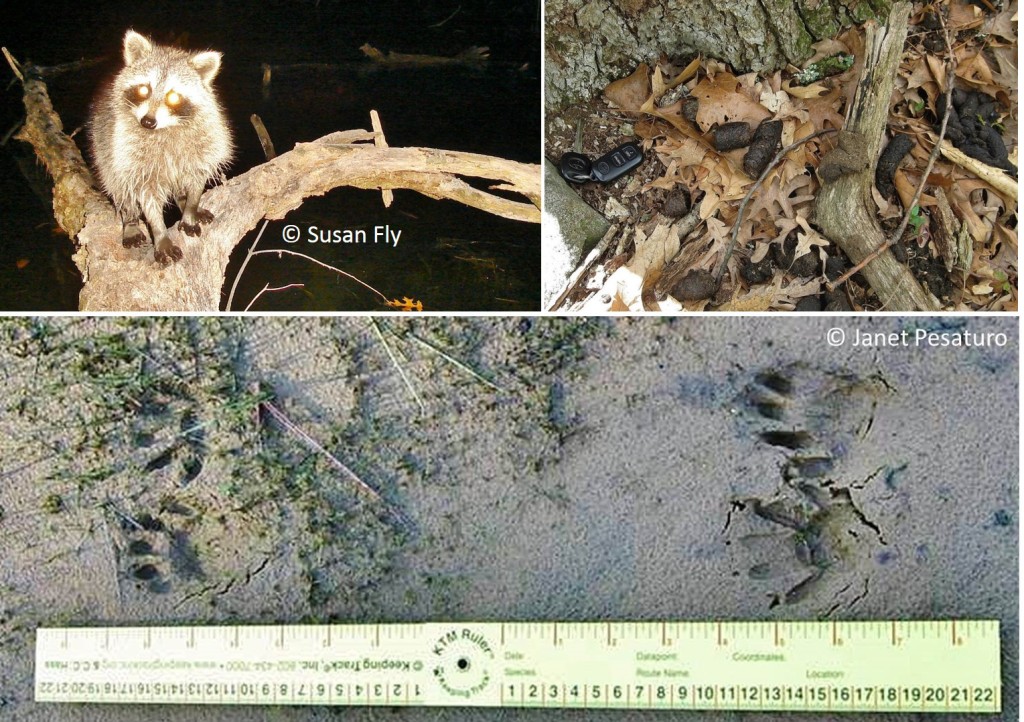
Raccoons are common chicken predators, so it’s important to understand them. Tracks look like tiny human hands, and you can see why, by looking at its paws in the trail camera photo. They might leave scat at scene of attack, and also leave scats in latrines, here at the base of a large tree.
Bear family
Bears are enormous omnivores which eat mostly plants, insects, and carrion, but will take livestock when possible. They can easily destroy most chicken coops. If you live in bear country, you’ll need electric fencing. We use it. Read here for detailed information about using electric fencing to exclude bears. I have no experience with grizzlies, but think of them as a larger and more aggressive version of the black bear.
Black bear
- Most likely to attack livestock in spring when they’ve come out of hibernation and little other food is available.
- Adults have very large tracks can be up to 6 inches wide. They have 5 toes on each foot but sometimes only 4 show. Claw marks usually show.
- Scat appearance depends on diet, but often looks like over-sized raccoon scat (untwisted, and as if it was squeezed from a tooth paste tube).
- Livestock death may be accompanied by other destruction that could be accomplished only by a large, strong animal.
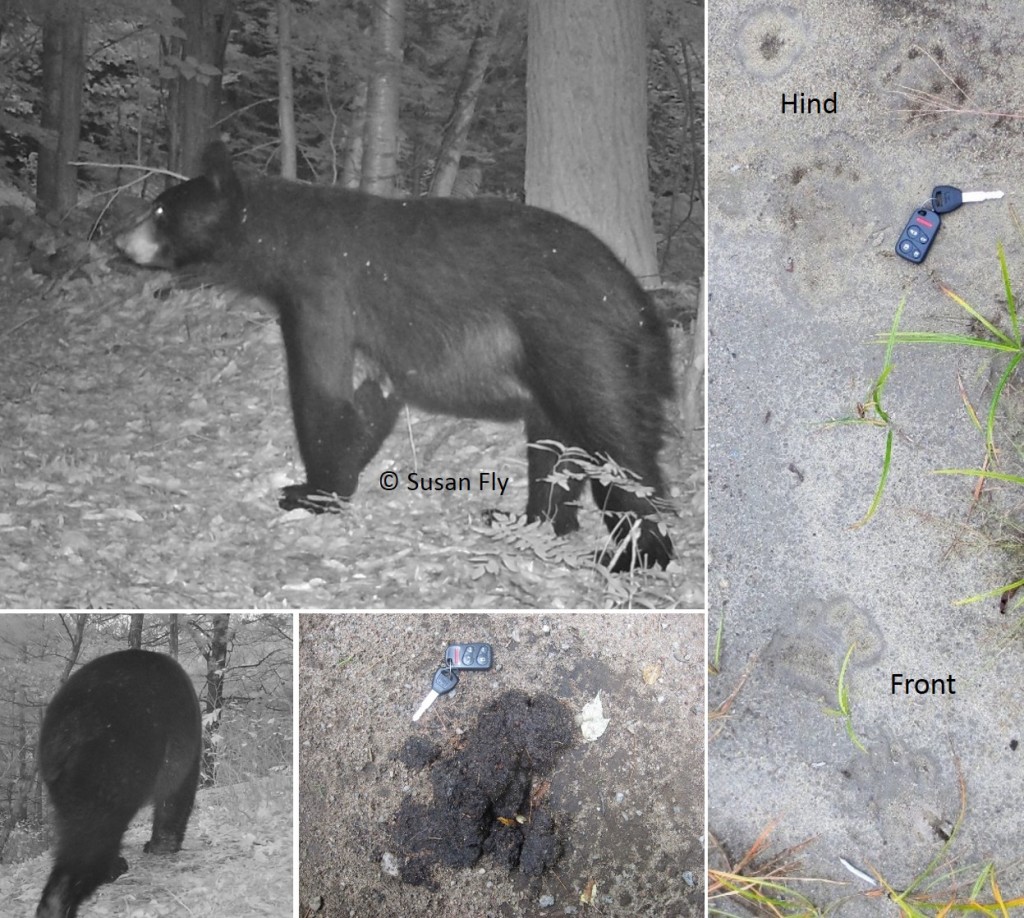
Game camera photos of black bear, giving you a sense of what its feet look like and how it walks. Look closely for the tracks in the photo at right. Scat, below, is very large.
Skunks
There are several species of skunk in North America, the most common and widespread being the striped skunk. The omnivorous skunk’s diet varies with the seasons. They eat plants, insects, grubs, worms, salamanders, small birds, bird eggs, and small mammals.
-
Tracks of striped skunk typically show all 5 toes and claw marks, and about 1 to 1.25 inches wide. Hognose skunk tracks are a little larger, and hooded, pygmy, and spotted skunk tracks are a little smaller.
- Most species are good diggers but not good climbers.
- More likely to eat eggs than adult poultry. May eat eggs right in the coop, and typically they bite into the egg at one end, and lick out the contents. You will find a large portion of the shell mostly intact, and the bitten off end will be crushed.
- Attracted to rodents in poultry housing, and may help reduce the rodent population. However, they do love eggs.
- Might predate on adult chickens, but because they did not evolve to kill large birds, they may maul them with multiple bites.
- Likely to kill only one or a few chickens.
- Usually nocturnal.
Virginia opossum
This omnivore eats a wide range of plant and animal foods, including birds and eggs.
- Tracks measure 1.25 to 3 inches wide. All feet have 5 toes, front track looks like a star, and hind track looks like a tiny human hand with an outstretched thumb. That thumb has no claw, but the other toes do, and may or may not leave pinpoint marks in tracks.
- Scat appearance varies with diet, and is rarely found.
- Excellent climbers
- Chews eggs into small pieces
- Did not evolve to kill large birds, but will take them if easily accessible, and kill by mauling, usually beginning at the cloaca.
- Usually kills only 1 at a time, and might consume most of the bird.
- Usually nocturnal
Rats
Rats chew up eggs in the coop or carry them away, and they chew up young chicks. I have read that they occasionally attack adult chickens on the roost, chewing the toes or breast. They probably enter the coop to dine on chicken feed, and to find shelter. Look for small pellet droppings around feeders. They are about 1/8 to 1/4 inch in diameter, and 1/4 to almost 1 inch long.
Snakes
- Rat snakes are the most likely to eat eggs.
- May be active day or night, depending on temperature. During extreme heat, they may be more likely to hunt at night, and during cool weather they feed during the day. They are mostly inactive in winter in colder climates, but they may come out on warm days.
- They eat entire eggs and young chicks, leaving no remains.
- You might find shed skins if a snake is living in your coop.
- The smaller the snake, the less damage it can do. Our runs are covered with 1/2 inch hardware cloth which will exclude snakes that can eat large eggs or chicks of standard breeds. Protect housing for bantam chicks with 1/4 inch hardware cloth.
Birds of prey
Birds of prey will attempt to take chickens. The larger the raptor species, the larger the chicken it can carry off, but smaller species will attempt to kill even large birds and eat them in place. Find out which species live in your region, learn to identify them, and read about their habits and hunting style. I will cover only the 3 species which commonly attack chickens in my area (east-central Massachusetts). Beware that raptors are protected by the Migratory Birds Treaty Act, and cannot be killed without a permit.
Cooper’s hawk
- Small hawk which cannot carry away a full size chicken, but will attempt to kill and eat in place.
- Those that stick around for the growing season learn that well protected chickens are not worth pursuing and generally don’t attack.
- New individuals passing through during fall migration may be very hungry and bold around people and come down for a chicken before your very eyes (I once literally pulled one off a hen).
- Fly within the tree canopy so it’s hard to see them as they plan an attack.
Red-tailed hawk
- Large hawk can carry off full sized hen, though awkwardly if it’s a heavy breed. You might find a few feathers or no remains at all.
- Juveniles are bolder around humans.
- Easy to see, as they perch on snags or dead branches, and fly over head.
Great horned owl
-
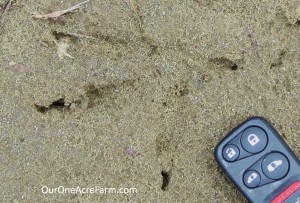
A great horned owl track. Note the prominent claw marks, consistent with a bird of prey with large talons.
Very large; can carry off adult chickens.
- Hunt mostly at night and at dawn and dusk, though occasionally take poultry during daylight.
- Typically decapitate victim, so if owl is frightened away before feeding, you might find a headless chicken.
- Informative video of great horned owl predating on chicken found here.
- May kill in excess, if the opportunity arises, and, like humans, cache the excess for later consumption.
- Learn to recognize their night time hoot which you can listen to here.
Opportunistic birds
Crows, ravens, magpies and jays will take eggs and young birds, and will also partake in chicken feed, if you make it easy for them.
- They might poke eggs open, consume the contents, and leave the shell, or carry the shell away and drop it elsewhere. Large birds can carry small eggs away in their beaks.
- Might enter the coop if you leave it open all day, and noise and activity are minimal.
- May learn your habits, work around them, and recognize sounds that indicate your imminent return.
- Crows are highly intelligent and work together. One might stand watch while another slips into the coop to eat an egg or carry it off.
Sources and further reading:
- Winterberry Wildlife
- Damerow, Gail. 1995. A Guide to Raising Chickens. Storey Communications, Inc. Pownal, VT.
- Elbroch, Mark. 2003. Mammal Tracks & Sign: A Guide to North American Species. Stackpole Books. Mechanicsburg, PA.
- Reid, Fiona A. 2006. Mammals of North America. Houghton Mifflin Company. Boston, MA.











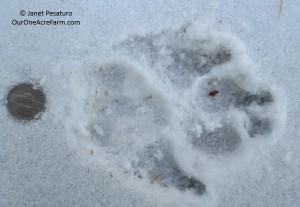

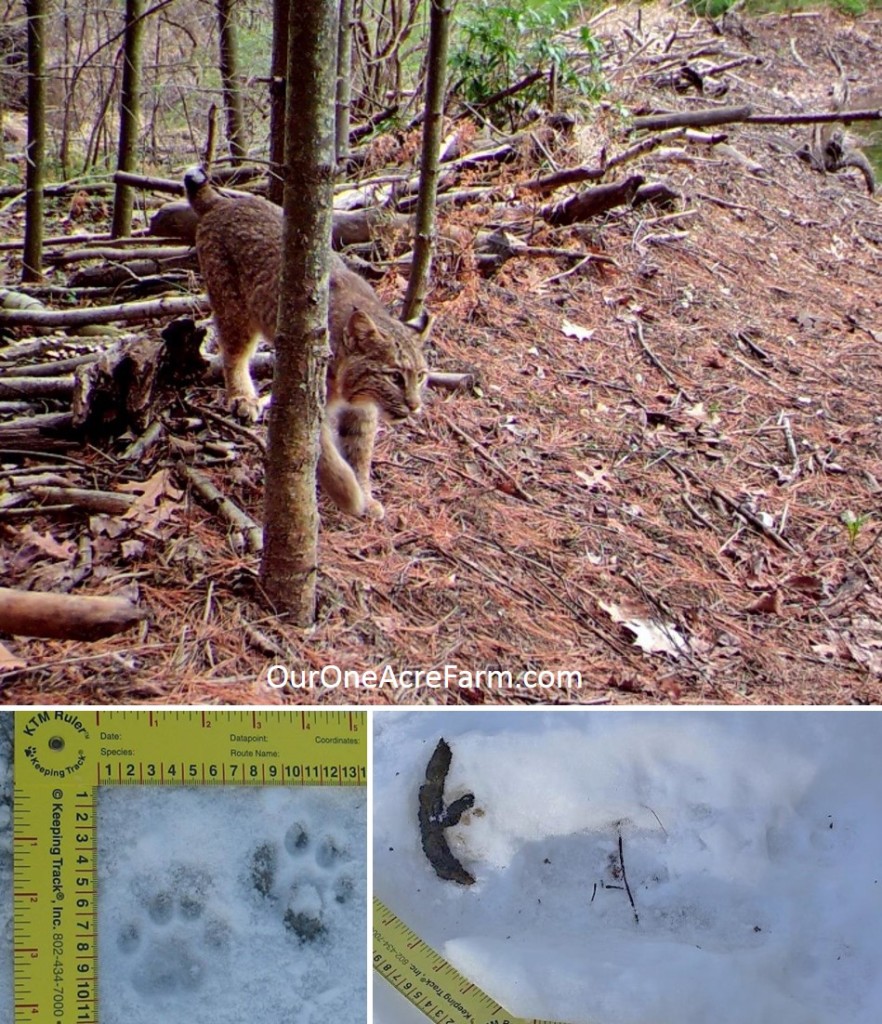
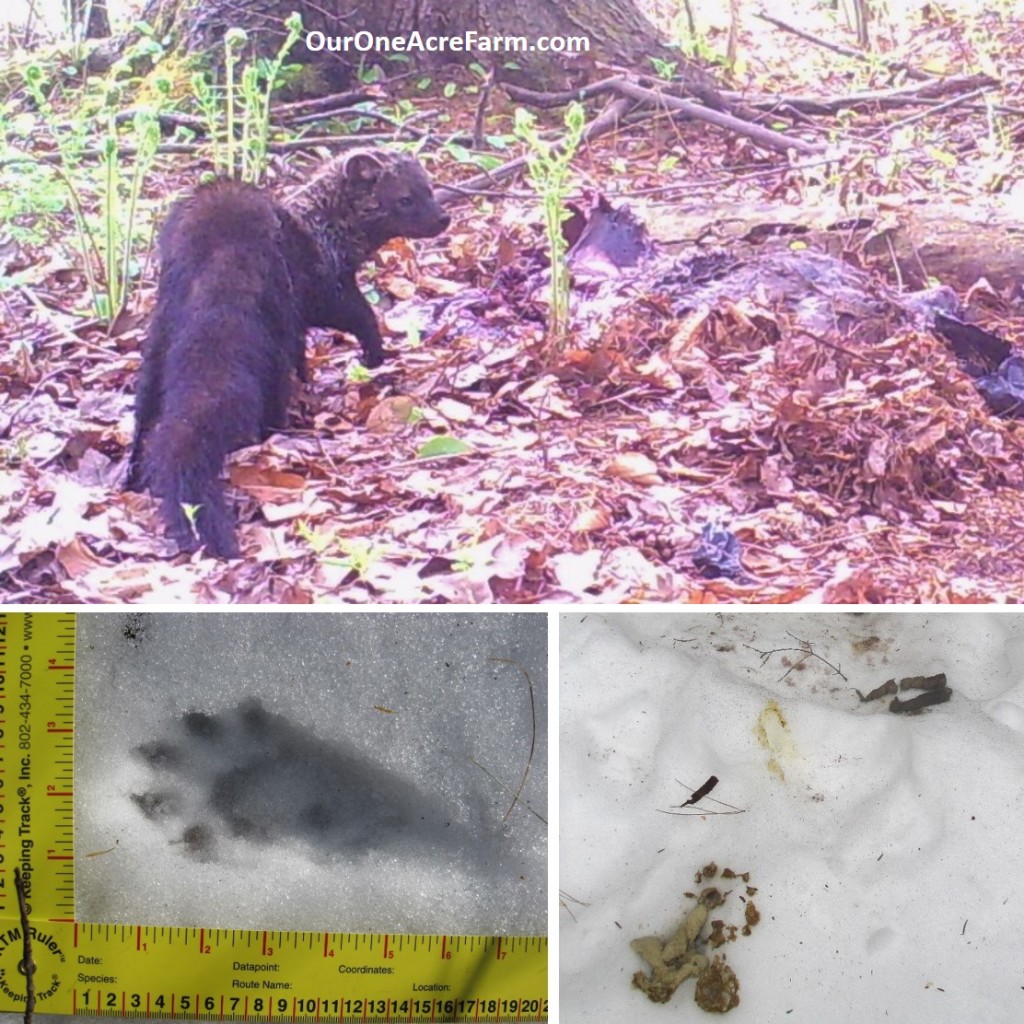
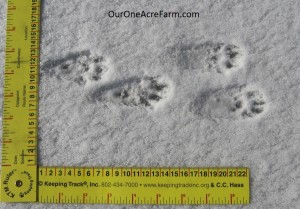

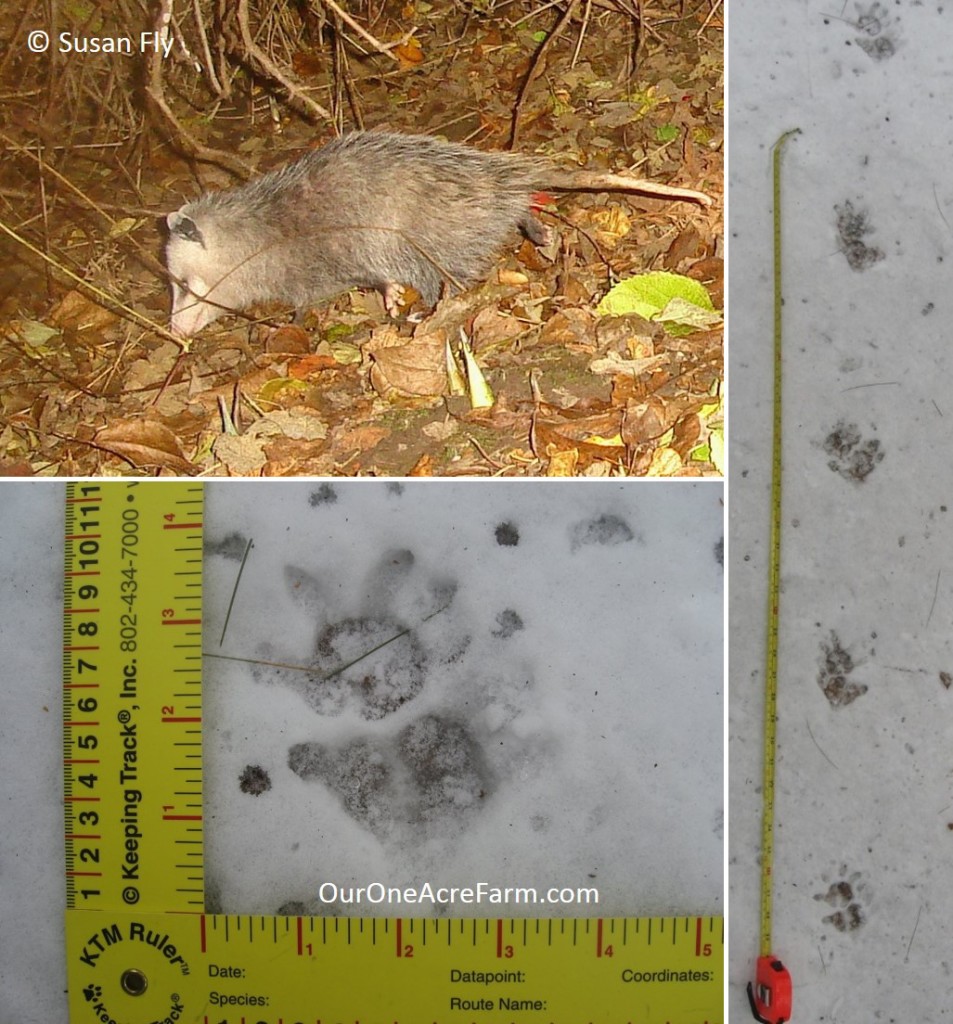
Janet- Thank you for this information. I wish it wasn’t so, but the timing is appropriate as we just had a fox attack and lost 5 birds in a very short time. It was devastating and heartbreaking to walk our property collecting the bodies. Very sad time. thanks for this helpful post.
OH no! I’m so sorry to hear that, Janet! Foxes are very bold around people and livestock, but can be excluded. If you’d like to discuss how the foxes got in and what can be done to exclude them and prevent future loss, please feel free. Thanks for stopping by.
Have free-ranging chkns led by a guinea hen who is a wanderer. Have lost a rooster & hens to various predators, fox, stray dog, hawks, coons, oppossum, & now a muskrat! Frustrating. Safe in house, but cooped up unhealthy. Have scratched into dirt the fully-fenced caged area, so must let roam ours & neighbors’yards for exercise & nutritional needs. Our dog used to guard them, but not much now due to cataracts, & oomph. Low budget to work with.
Hi L.S.! I’m sorry to hear you have suffered so many losses! I will be posting in the near future specifically on how to deter predators, but for now I’ll say that in the end, proper fencing and preventive measures are cheaper because you stop losing animals, and less time consuming, because you don’t need to stand guard or set traps. Complete free ranging is a losing battle, imo, but if you can fence in a large area they can still have access to wild forage, but won’t walk into the mouths of predators. It’s all in how you set it up, how much cover they have and where it is, and what your habits are around the property. We just received Predator Friendly certification and I will post all about how we deter predators in the coming weeks. Thanks for stopping by!
I agree with Janet. Chickens have got to be penned up, but that doesn’t mean they aren’t healty or happy. A large, covered, secure run is your best bet. Free ranging never ends well and as Janet mentioned, in the long run, it’s probably less expensive to build a nice run than to keep losing chickens – besides the heartache factor which to me isn’t calculable. Great guide to the various predators that we all have to deal with.
Thanks, Lisa. I don’t ever let mine completely free range anymore, but in good weather, I do let them run around for about 1/2 the day in a large (1/3 acre) yard that is fenced (not covered). I let them run around there only when I am home, and it’s set up with plantings in such a way as to minimize predation. I call this “limited free range” and have written another post on it. In about 8-9 years of doing that, I have lost only 1 bird to a predator (a hawk). All of this is to say that with proper planning and care, it’s possible to give them quite a bit of freedom without fully free ranging them, and that can greatly improve quality of life.
My friend keeps an Osterige to guard his chickens and sheep. He says its two front feet are very powerful and they will defend the other animals..
Sorry Ostriche..my cell spelled wrong and not sure how to edit post. Good luck, waiting to see a Gray Fox mom and kits now in Pine Grove, Ca.
I am reluctantly coming to the conclusion that free-range is not a viable option, have been compelled to kill predators or lose the chickens. I don’t want to kill anything, so I guess I must contain the chickens. Found feathers on the lawn, 200′ away found a head partially buried in the freshly-tilled garden, the predator must not have been heavy enough to leave tracks in the clay crust around the buried head. I can let you know when I solve the mystery.
Pingback: Poultry Predator Identification: A Guide to Tracks And Signs | Homestead & Survival
Great information. We have come to realize (the hard way) that we cannot have our birds free range anymore. We are currently working on a new large enclosure that includes access to pasture, brush and a small creek, we call it our poultry habitat 🙂
Sounds excellent, Lindsey. Free ranging is dangerous, for sure. I love the idea of a large enclosed “poultry habitat”. We have enclosed runs, but we also let them “free range” for half the day in large fenced yard. We can’t let them out into that all day, for they are too vulnerable to hawks, so we compromise and give them half the day while I am home and able to keep an out on them.
I free range my ducks and haven’t lost one during the day. I have lost 3 at night and it just breaks my heart. Last night something dug under the fence and got in one side of the pen. It ate an egg then got the brooder. There is nothing left except feathers. I can see small feathers in the hole where it looks like it pulled her out by her neck. It just absolutely breaks my heart. If it is digging holes to get in then how do you even begin to try to trap it?
Pingback: Chickenpalooza! Homestead Chicken Resources
Pingback: Identifying Chicken Predators | The Homestead Survival
Pingback: Identifying Common Chicken Predators & What Killed Your Chicken: 'What The Cluck?!' Session 13 [Podcast] |
we had a bear kill all our chickens last year. We’d like to get more but are worried about keeping the bear out of the coop since it obviously has enormous strength. Any ideas? We thought about an electric fence, would that keep a bear out?? love your website!
Kerri, yes electric fencing can help (though nothing is 100% effective). Bears are quite strong and could demolish most chicken coops, so do consider electric fencing. See the section on bears above. Good luck!
Pingback: Do Raccoons Eat Chickens? - Countryside Network
I had my 2 old hens killed a couple of weeks ago by fisher cat. I want to install hardware fabric in my run- is 1/2″ ok? or must it be 1/4″ to keep them out?
Sorry to hear of your loss, Linda! Fishers are much too large to get through even 1/2 inch hardware cloth, but you need the 1/2 inch to exclude small weasels. To keep fishers out, make sure the hardware cloth is strongly secured, because they are strong and might try to pull at the hardware cloth.
Pingback: Homestead Chicken Resources - Everything for Your Backyard Flock
We’ve had 2 chickens killed in broad daylight thought it was a coyote but later we found one of the bodys in the barn and feathers of the other one in there as well wondering what it was
Hard to know, Erling, without a lot more information. There are many predators who would kill chickens during daylight.
Just lost a chicken to a predator. Cant find any pieces of the bird just feathers. No sign of entrance for the animal to get in and no sign of blood or anything leading to the carcass being taken out. Ground is dry just a pile of feathers under the coop and another in the corner where the hose is. My coop is on stilts and the run is attached with an auto door for the roost, completely closed in with hardware cloth with only a small maybe 2.5 in gap between the tin roof and the framing, no signs of digging. found print shows five toes and a pad
I’d be happy to try to id the predator if you’d like to send photos of the track, feather piles, and your coop/run set up, to the email address in the Contact section of this blog. From what you say so far, it seems that only a small predator like a weasel or mink could get in, but I cannot imagine either of them could consume an entire chicken, leaving nothing but feathers. It doesn’t add up.
Could you please email me to see if you can help me determine what killed my chickens?
Just lost 4 young guenneas, 3 young turkeys and a young hen last night, looks like it dug about 2 inches under our enclosure and about 3 inches wide and just killed them all didn’t eat any of them. No tracks that we could find.
Sorry to hear that, Jamie. I hope you have fortified your set-up to prevent future events like that.
We have had for at least 10 years a carport housing our chickens. Recently, I have been losing every other day a chicken from my enclosed carport. I do have lattice on the upper portion of 2 sides. Just this morning we found some small scat on top of our laying boxes. We found a rat’s nest against one of our bottom walls outside of the carport and we noticed at least 3 rats were living in this nest but were unable to dispose of them. Could these 3 rats be the culprits? Keep in mind this observation: whoever is doing this leaves the wings with the feathers on and the skeleton intact. It eats the head, legs and torso. Feathers could be someplace else. My question is any ideas on what predators are doing this? Thank you in advance!
Yeah, that sounds like a small animal, because a larger predator would take the whole chicken and/or leave less of it intact. Since you have a rats’ nest, that would be my first suspect.
Losing a chicken every other night or so all I’m finding is a pile of feathers nothing else caught a possum in trap disposed of was good for 2 nights and then somthing got 2 more and found 2 piles of feathers side by side and these are full size laying hens. What ever it is can eat 1-2 a day in 1 setting and leave nothing but feathers. It doesn’t go very far n the woods to do it either think it’s happing rite after day lite when I go to work and it could be getting them 15-20 foot in the tree above there coop were they roost now cause it looks like sumthing getting bark ruffed up on tree to the limb they roost on they to afraid 2 even go in coop I believe.
Hard to say from the info you give. Not sure where you are, geographically, and not sure what sorts of openings are in your coop/run, so not sure which predators can fit in. If it’s getting in from a tree above, possibilities include raccoon and fisher, and possibly gray fox, all of which climb trees. In any case, you need to secure your set-up so nothing can get in. Killing the predator will be only a temporary solution, till the next one finds your birds.
I live in NH, and we get kills simular to that above. A fox will take one maybe two every two to three days depending on its family size, and will come day or night when ever it is quite. They grab, run, then kill, eat some for themself, and bring the rest back to the family. Being mid August and it is take two at a time, I would say it has a kit along learning the trade. If you find a lot of feathers at the coop, and a body of the bird with out its head, neck, and or breast meat, you have a fisher or a mink; but most likely a fisher. If so lock the remaining birds up!!! because it will be back and this time (if it didn’t on the first night) will kill every bird in your coop, eat it’s favorite parts till its full and then come back every couple of nights to remove the kills one at a time. Trust me I have learned the hard way.and have lost a bunch of birds throughout the years. Hope this helps in some way.
Thank you Dan. I was struggling to id a predator and as we have fisher, this could be it. I’m a bit confused because I lost a hen in October with no signs of attack or carcas . This time, yesterday her sister was hit. Found pile of tail feathers then another feather pile 80 feet away and on the other side of a pond and next to a fence post. 20 feet from that I found the headless body, ripped off wing and some body meat missing. It happened around 3 pm in the daylight so I sort of ruled out the fisher and was thinking Great Horned Owl as my neighbors have been hearing them and heard one last night at 10 and close to the scene.
Thank you also Janet for this excellent and informative sight. Any thoughts appreciated.
I live in VA. unfortunately I have lost 2 birds in the last 2 months. We have electric fence and so they are free roaming. 1st one during daylight, was a full grown cuckoo maran, just left a pile of feathers. I thought maybe a hawk, so I put out a scarecrow, I moved every other day. Yesterday eve went out to put them away, there was my Wyandotte, half eaten (one side) with feathers scattered everywhere.
Am I correct in thinking it was a hawk? if so what options?
Thanks
I live in Kansas I had 14 chickens 12 hens and 2 repeaters and one mooring I woke up and only had 7 ,6 hens and 1 rooster 4 were gone 2 were out in the pen with the heads and neck gone then 2 days later 2 more hens killed in the coop neck and head gone then this morning one more hen in killed the same way I’m down to to one rooster and 3 hens my husband and I have our coop completely covered no holes so we’just don’t understand what’s getting in there we put up a game camera tonight hopefully we’ll see the culpret I love my chickens I love getting fresh eggs this is so depressing to me
I have a small one acre property in Northern Arizona with a small flock of Old English Gaming fowl. This evening one of my adult hens and two pullets are missing. There was an area where a struggle appeared in an open forest of cedar & mesquite. There were piles of feathers over a ten foot area from the adult hen. However, the two pullets just disapeared. I am confused because a raptor can’t fly off with a hen, and which animal can take three victims at one time?
I recently broke my leg and my husband and son have been caring for my birds not thinking they were feeding enough because of utilization of the quantities feed. They finally realize I’m missing birds -used to have over 50 layers rare breed s! all have disappeared in the past 45 days ! this past week I have lost six khaki Campbell ducks in two days! nothing left now but my peacocks &geese ! En closure is fenced with cattle panels 4 foot tall covered in chicken wire with 1 inch holes andwith netting entire roof .chicken coop well-made buried underground walls electric wire running at the top of the 4 foot cattle panels .we are not finding anything !no bodies no feather s!! Nothing! Whatever is taking these birds is fitting through a 6 x 6″ square in the cattle panel.
I cried this morning over my dogs I am still not able to even go outside and this is stressing me out beyond believe we have looked everywhere and the only holes we have found is where the chicken netting is pulled off of the cattle panels but what could fit through a 6 x 6″ hole yet be strong enough to carry off an 8 pound Cochin or a large duck?? not leave a single trace? One side of this pan is a horse pasture with woods on the other side of the pasture and the chicken pen is only 50 feet from my house with that side is facing my yard . I am heartbroken I don’t know what to do I have baby geese that I have inside the house that need to go out and I’m terrified because they’re only two months old they’ll be eaten immediately I’m just at a loss of what to do now.
Hi Janet. Your farm sounds heavenly. Wonderful article and very informative. We have been free ranging our chickens during the day on our acre of land and then closing them in their coop/completely fenced run early evening. This has been working well until just yesterday when I discovered my sweet Henrietta was gone. It had to happen around 10:30am and the clues were two piles of scattered feathers. Do you think it was a hawk? I am so heartbroken as this is my first time raising chickens and my first loss.
I live in red bluff,can. In a 2 week period I have lost 12 hens and 2 roosters. No proof left behind until this morning I went to chicken coop and 1 rooster and 1 hen and baby chick were gone. Thought they flew over chicken wire but then I found baby chicks mother dead and headless in the coop. That’s when I realized that my chickens were disappearing from their sleeping area in the fenced in coop. No holes but no covering either. Tree over the coop so predator could jump in but would have to jump 5 yo 6′ over fencing or 10′ onto roof to get back into tree with full chicken.
I meant red bluff, ca. Mountains what kind of predators can jump or climb that high with 2 full grown chickens. The only reason I found the mama hen in the coop was because she was very protective over her chick that was also missing. She probably attacked the predator and it took her head and left her body but didn’t leave any parts of the other 14 chickens it took in a 14 day period.
I live in Washington state and I have lost 2 hens. Both had their neck eaten not the bone. And the head and body was left. Can not find any holes under or in fence and the top is covered with no holes in it..any ideas?
ii have been loosing chickens the last 6-8 weeks but have only found feathers 1 time. the chickens used to go in their pen without any problem until chickens started missing. I found the remains ,wings & backbone of two .then the rooster would run all of the hens out of the pen at dusk. the last one I lost ,2 days ago only feathers under the tree where they were roosting in. I didn,t have a problem as long as I had a dog. mine died after getting run over by a car ,but he was 15 years old & deaf.
Pingback: Chicken Predators: Know Who They Are & How to Protect Your Chickens - Grid Down Tools
We just lost 4 ducks in one night but no trace at all…no feathers, no carcass or any remains. We are wondering what predator got them, they just disappeared. What could have got them?
I found one of my CHICKENS IN MY Neighbors dead its neck was broken and it had part of its breast torn open I’m trying to figure out what killed it any suggestions?
Got a duck and got killed but is no trace of her
I have a duck that got killed but no trace
Please help me figure out what it is it also killed all my Guinies
Today I just found a chicken only eaten on one side. Barely any tracks in the enclosure area. The coop is within the enclosure. The door was locked to the enclosure but the enclosure does have about a 12-15 foot fence. Could a fisher cat climb over that high and come down in snow without leaving a ton of tracks? I find it odd it didn’t try to attack the 14 other chickens and only leave a half eaten chicken. There are bobcats on the property but the tracks are too small on the outside of the enclosure.
There are a lot of animals that could get into that enclosure. Without seeing the kill site, tracks, and snow texture myself I can’t say what could have done it without leaving more tracks. Fishers, raccoons, opossums, weasels, martens, and bobcats could all climb the fence, and of course owls and hawks can fly into it. The description of only one bird killed and only half eaten, sounds most like an opossum to me.
Two of my chickens where killed in less than a week and 1 is missing plus i have two chickens which are having marks on neck with dots of blood.Am not sure whats going on,i try to investigate but there is no clue
We had a duck taken last night no prints in the area. No card is only a pile of feathers. He was a large gull grown duck
We live in Pennsylvania.
I have a large flock of hens with a one-year old Heavy Red Rooster. Today he and 2 hens were killed at noon – we live in a rural(ish) part of southern Ontario. This is our first daylight kill such as this – we use an electrified fence and have, over 6 seasons, not lost any birds. One was eviscerated, one had a small puncture on her back and Mr Friendly had blood around his head and lacerations on his back. Lots of feathers indicate a prolonged fight. I’ve not been able to find out what would have killed them. Any insights are very welcome. I took pictures if that helps.